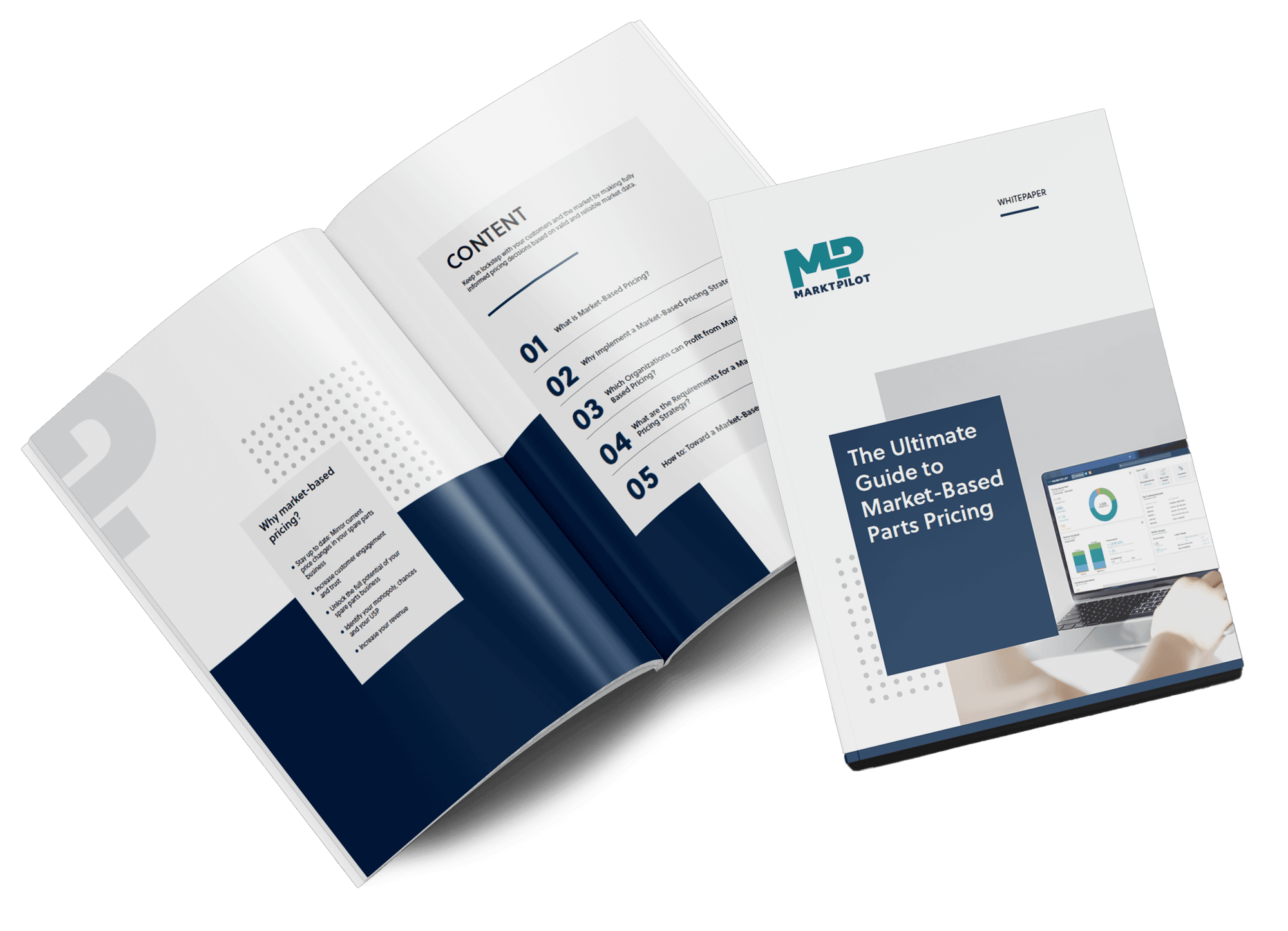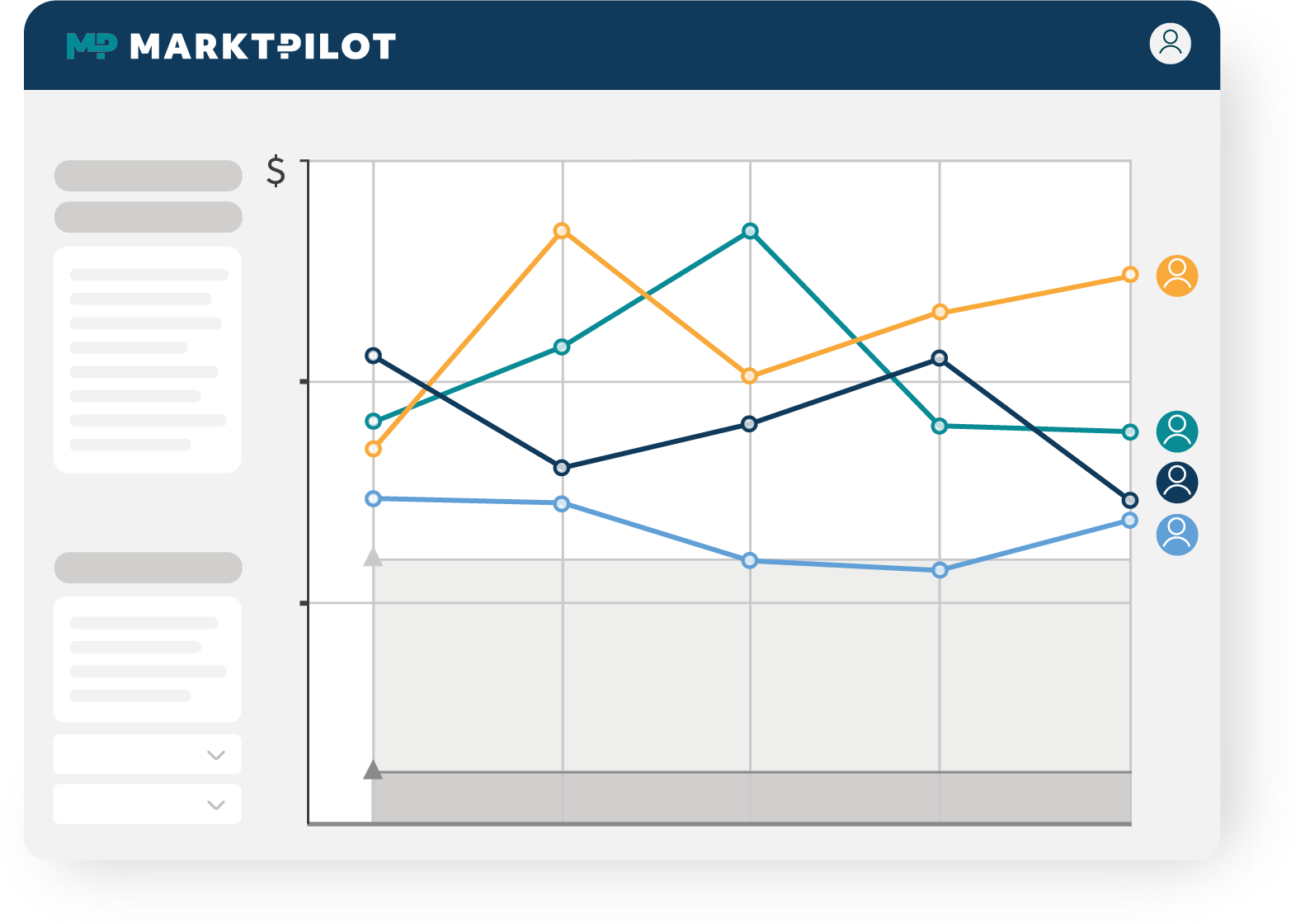Spare Parts Pricing Software
Spare parts pricing software helps machine manufacturers set market-based prices, boost efficiency, and increase profitability. Powered by AI and advanced analytics, it ensures accurate pricing while minimizing manual effort. Discover how MARKT-PILOT can transform your pricing strategy—watch the video now!
What Does a Spare Parts Pricing Software Do?
A pricing software analyzes, manages and sorts price information and thus, simplifies pricing. It's also called Price Management Software.
Pricing software, or Price Management Software, refers to flexible tools that enable machine manufacturing companies to set and manage prices for items like spare parts with ease and efficiency. This is then usually used to forecast, optimize and implement a company's pricing strategies. Aftermarket pricing solutions help businesses adjust prices for specific markets, manage discounts, and make real-time changes when needed. For companies in machine and plant manufacturing, this tool is essential for both short- and long-term pricing decisions. It streamlines pricing strategies, helping businesses increase sales, protect profit margins, and improve their overall pricing process.
Implementing Pricing Strategies in the Spare Parts Business With a Pricing Tool
An efficient pricing strategy is crucial for success in the aftermarket of machine manufacturing, particularly when it comes to spare parts. It acts as an essential pricing reference and is crucial in selecting the right pricing software.
However, the pricing strategy extends beyond the mere utilization of pricing management software. It encompasses the objectives established for the aftermarket and helps machine manufacturers in determining the sales prices for spare parts. Moreover, it takes into consideration several relevant factors that influence the decision-making process for setting the optimal price.
By employing pricing software in a targeted manner, parts pricing optimization can be effectively implemented, leading to maximum profitability in the spare parts business and the attainment of competitive advantages.
What Are the Benefits of a Spare Parts Pricing Software?
An ideal pricing software for spare parts should include features that enable sales staff to optimize pricing processes and improve overall profitability in machine manufacturing.
- Data Analysis and Price Monitoring: Modern pricing software uses advanced analytics to help manufacturers quickly analyze large datasets and identify pricing opportunities. This data-driven approach enables companies to make smarter pricing decisions and boost profit margins.
- Price Optimization: Pricing management software also assists in analyzing external and internal data to understand the perceived value of products. Price optimization is about finding the price point that resonates with the target audience and supports the pricing strategy.
- Efficiency and Competitive Advantage: In a marketplace where competition is fierce, getting the pricing right is key to success. Aftermarket pricing solutions help to understand demand and price elasticity, make informed pricing decisions and map the current market. The tools also help to automate manual processes and increase efficiency in pricing process.
- Increase in Turnover: Spare parts pricing software helps manufacturers increase profit margins by using automation and algorithms. It ensures prices are set based on market demand, helping maximize revenue and improve overall profitability.
The Most Important Features of Spare Parts Pricing Software
An exceptional pricing tool for spare parts should prioritize enhancing operational efficiency and optimizing business success. In an era of rising transparency and an expanding array of comparison options, pricing complexities have surged. Thus, it has become vital to incorporate market awareness, including third-party offers and prices. The optimal software therefore presents not only its own market information, but also the relevant information of competitors.
An ideal spare parts pricing software should include features that enable sales staff to generate customized prices for individual customers or customer groups. These functions should consider various factors such as volume, payment terms, contract terms, customer value, and objectives. Furthermore, pricing solutions should provide analytical capabilities that assist in implementing the defined pricing strategy based on the mentioned criteria. By simplifying and digitizing the pricing process, a pricing software becomes valuable as it enhances efficiency.
Amongst the most important features for parts pricing optimization are:
- Market-Based Pricing Insights: Real-time analysis of market trends and competitor pricing.
- Dynamic Pricing Adjustments: Automated price updates based on demand, costs, and market conditions.
- Integration Capabilities: Seamless integration with ERP, CRM, and other business systems.
- Data Analytics & Reporting: Advanced analytics for tracking performance and identifying pricing opportunities.
- User-Friendly Interface: Intuitive dashboards and tools for easy navigation and decision-making.
- Scalability: Ability to handle growing data and business complexity as the company scales.
- Pricing Simulations: Tools to forecast the impact of pricing changes on revenue and margins.
- Security & Compliance: Robust data protection and compliance with industry-specific regulations.
What do you have to look for in a spare parts pricing strategy?
"In the end, prices have to be competitive and able to survive in the market in order to maximize sales and company success. For this, the right pricing tool is a crucial factor. Especially in the key account area, it is important to have a stable data situation and market overview. A market-based pricing strategy for spare parts provides important negotiating advantages here."
What features must a good pricing tool have?
"A good pricing tool must be able to take into account prices researched on the market. Regular price research and collection of market data are important to be able to determine prices correctly. For most machine manufacturers, the spare parts business is the key to corporate success and sales increases. Relying solely on overhead costing is no longer enough to survive in the market and operate the spare parts business profitably."

Stefan Deuschle
Head of Customer Success
at MARKT-PILOT

Increased Revenue With Market-Based Spare Parts Pricing
In our Ultimate Guide to Market-Based Pricing, you'll gain necessary knowledge and insights related to the nature and implementation of market-based pricing strategies. Learn how to make pricing in the parts business even more effective and profitable.
How MARKT-PILOT as Pricing Tool Optimizes Spare Parts Pricing
Automated market price research provides machine manufacturing companies with all the information on prices and delivery times for their spare parts in one overview, enabling them to act accordingly and establish market-based pricing. With spare parts prices that are based on current and sound data and are fairly aligned with the market, companies gain the trust of (new) customers and counteract the price sensitivity of buyers. MARKT-PILOT aftermarket pricing solutions offer:
- Assistance in implementing the market price information
- Carrying out a risk analysis by considering critical value drivers
- Defining a parameter by which to measure the confidence level of pricing decisions.
- Minimizing manual effort to arrive at a successful pricing decision across a larger number of parts
- Revenue simulation making revenue and margin visible and predictable
PRICERADAR enables data-based and intelligent pricing decisions thanks to first-time transparency on competitors, prices and lead times. PRICEGUIDE takes the guesswork out of pricing. By harnessing its smart, data-driven insights, machine manufacturers can improve pricing quality while steadily increasing spare parts sales over time.

Market insight is the key to a successful spare parts pricing strategy.
Simple Implementation
Ready to use in less than 30 minutes. No integration or training required.
Accurate Results
MARKT-PILOT takes over market price research for spare parts and delivers validated results through a 1:1 comparison.
+24,500 data sources
Access to validated data points from various online and offline sources for unrivaled data accuracy.
Customer Success Story: Kardex Mlog
THE CHALLENGE
Achieving optimum prices while maintaining customer satisfaction is an extreme challenge for machine manufacturers. This was also the case for Kardex Mlog.
Until now, price differentiation could only be defined by product groups and was therefore associated with a great deal of effort. Additionally, price adjustments only occurred once a year. With customers able to obtain information about prices, delivery times, and the availability of spare parts on the market at any time, Kardex Mlog was faced with a challenge.
EFFICIENT PRICING WITH STRONG MARKET DYNAMICS
The solution? PRICERADAR from MARKT-PILOT. Kardex Mlog has been using the MARKT-PILOT solution for more than a year and has been able to immediately react to market dynamics by conveniently adjusting spare parts prices several times a month.
Especially with the current market dynamics, it pays to have a tool like PRICERADAR. After all, what’s wrong with adjusting prices three times a year? Mlog’s customers also benefit from the increased flexibility and consistently increased potential.
Conclusion: Spare Parts Pricing Software for Machine Manufacturing
A pricing software serves as a centralized hub for all pricing data, streamlining the time-consuming and manual process of data evaluation. It facilitates the implementation of diverse pricing strategies and forms the foundation for swift responses to market fluctuations. It's important to note that the effectiveness of any software, including parts pricing optimization tools, hinges on the quality of data it is provided with, as it significantly influences the final outcomes.
By partnering with MARKT-PILOT, companies benefit of more than 140 years of experience in the aftermarket of machine manufacturing combined with innovative AI. Our solution enables the parts business of machine manufacturers to remain profitable even in dynamic markets and reliably make price potential of spare parts visible – for more sales and higher customer satisfaction.
Watch Video: Spare Parts Pricing Software
FAQs
What Is Spare Parts Pricing Software, and How Does It Work?
Spare parts pricing software uses advanced data analytics and market intelligence to optimize pricing strategies, ensuring machine manufacturers set competitive, profitable prices for their spare parts.
Why Is Spare Parts Pricing Software Important for Machine Manufacturers?
It helps machine manufacturers navigate market complexity, manage fluctuating costs, and improve margins by offering data-driven pricing insights, reducing manual effort, and increasing operational efficiency.
How Can Spare Parts Pricing Software Improve Profitability?
By analyzing market trends, customer behavior, and costs, the software identifies opportunities for margin optimization, adjusts prices dynamically, and eliminates pricing inefficiencies.
What Features Should I Look for in Spare Parts Pricing Software?
Key features include real-time market analysis, integration with ERP/CRM systems, customizable pricing rules, and advanced data analytics and reporting options.
How Does MARKT-PILOT Support Machine Manufacturers With Spare Parts Pricing?
MARKT-PILOT provides AI-driven spare parts pricing software that delivers market-based insights, improves profitability, and ensures manufacturers stay competitive in a dynamic market.